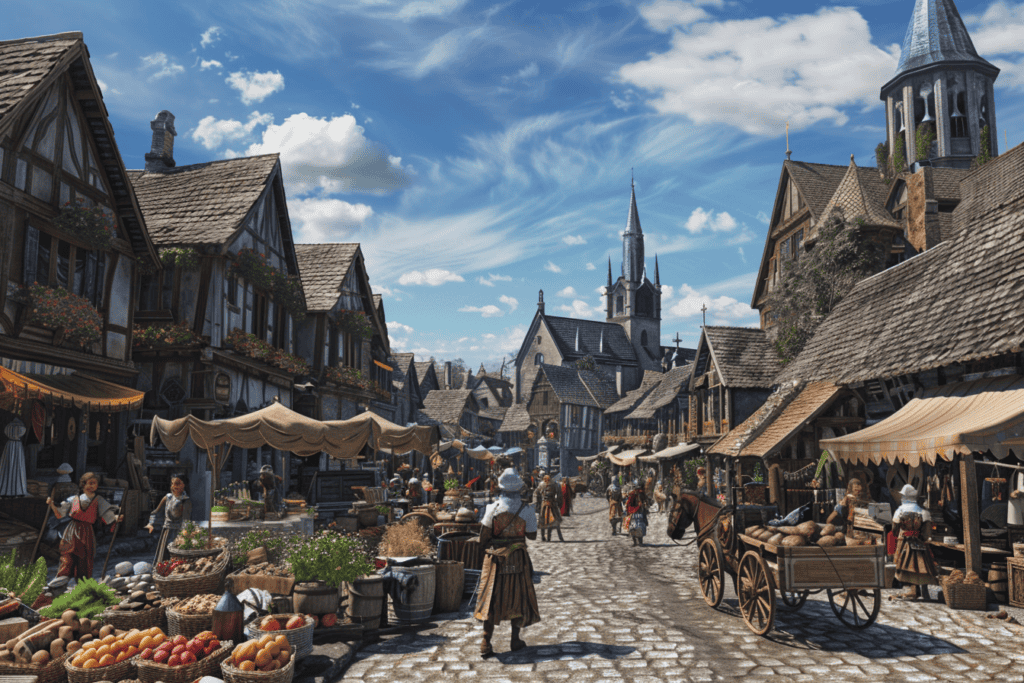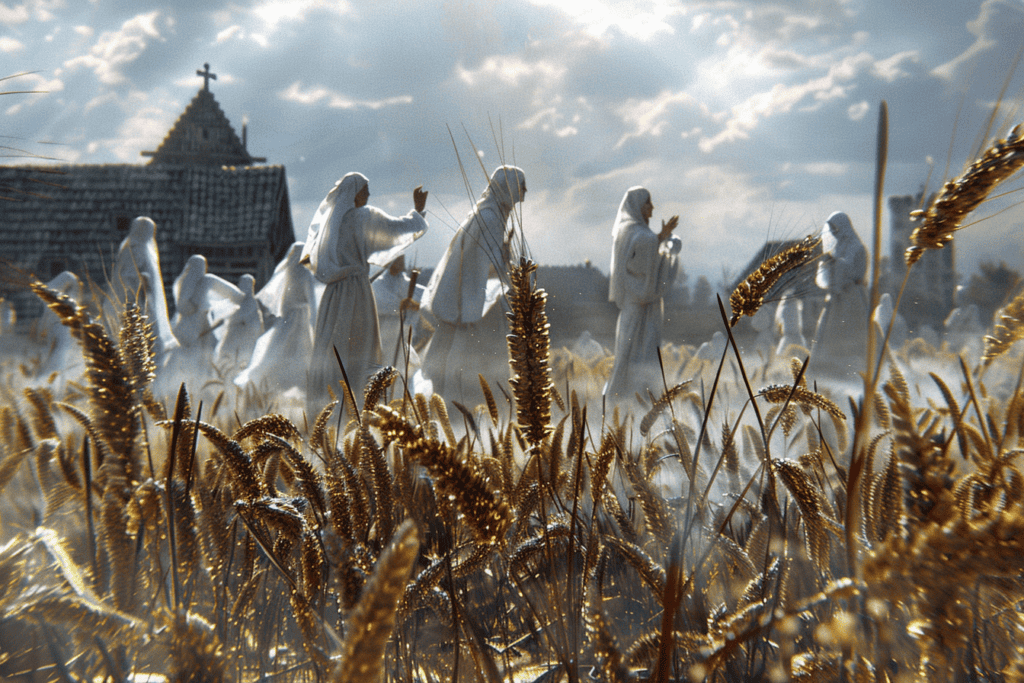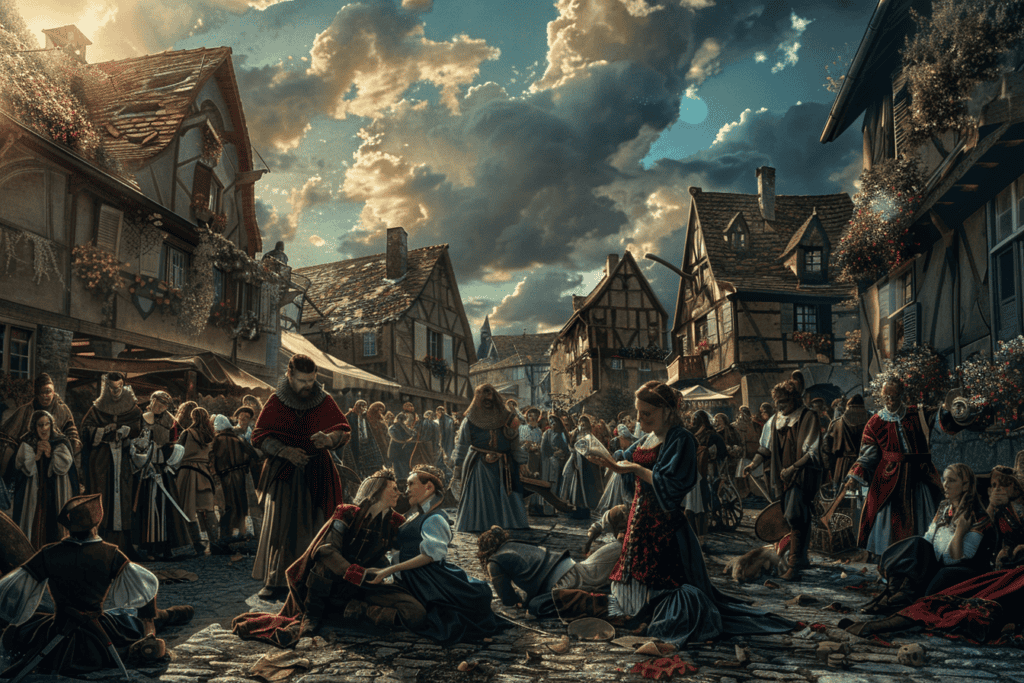In the summer of 1518, the streets of Strasbourg, a town in modern-day France, became a dance floor of death.
The mysterious and deadly epidemic known as “The Dancing Plague of 1518” took over the town, causing people to dance uncontrollably for days on end.
The outbreak began with a woman named Frau Troffea, who started dancing in the city’s square without any apparent reason.

As the days went on, more and more people joined in the dancing, and the phenomenon soon turned into a deadly epidemic.
The dancing was so intense that many people collapsed from exhaustion, suffered heart attacks, or even died from the physical strain.
Despite the tragic consequences, the dancing continued for weeks, until the authorities finally intervened and put an end to the madness.
The Dancing Plague of 1518 remains one of the most mysterious and fascinating events in history. While there are many theories about what caused the outbreak, no one knows for sure what really happened.
Some believe it was a case of mass hysteria, while others think it was caused by a toxic fungus or a virus. Whatever the cause, the dancing plague of 1518 is a reminder of how strange and unpredictable human behavior can be.
Europe in the Early 16th Century

The early 16th century was a time of great change and upheaval in Europe. The continent was still recovering from the devastation of the Black Death, which had killed millions of people in the 14th century.
The Renaissance was in full swing, and new ideas were challenging the old ways of thinking.
The Holy Roman Empire, which included much of modern-day Germany, was a patchwork of independent states and territories, each with its own laws and customs.
Previous Instances of Dancing Mania
Dancing mania, or St. Vitus’ dance, was not a new phenomenon in Europe. In fact, there had been several outbreaks of the strange behavior in the centuries leading up to the events in Strasbourg in 1518.
The earliest recorded outbreak occurred in the 1370s in the Rhineland region of Germany. In these outbreaks, people would dance uncontrollably for hours or even days at a time, often until they collapsed from exhaustion or died.
There are various theories about what caused these outbreaks of dancing mania. Some historians believe that it was a form of mass hysteria brought on by stress and anxiety.
Others suggest that it was a reaction to the social and economic upheaval of the time. Still, others believe that it was a form of religious ecstasy or a reaction to the use of hallucinogenic drugs.
The Strasbourg Dancing Plague of 1518 was the most famous and deadly outbreak of dancing mania. It began when a woman named Frau Troffea started dancing in the streets of Strasbourg in July of that year. Within a month, hundreds of people had joined her, and the dancing had spread throughout the city.
Many of the dancers collapsed from exhaustion or died from heart attacks or strokes.
Despite the many theories about what caused the dancing mania outbreaks, there is still no definitive answer. It remains one of the most intriguing and mysterious phenomena in European history.
The Outbreak of the Dancing Plague – Frau Troffea’s First Dance

In the summer of 1518, a strange phenomenon took over the streets of Strasbourg. It all started when a woman named Frau Troffea stepped outside her home and began to dance.
Her movements were uncontrolled and erratic, and she seemed unable to stop herself. At first, people were amused by her antics, but as the hours passed, it became clear that something was seriously wrong.
Frau Troffea danced for hours on end, and when she finally collapsed from exhaustion, it was clear that she was not the only one affected by this strange affliction.
Soon, other people in the city began to dance uncontrollably, and before long, hundreds of people were caught up in the bizarre and deadly dance.
Spread and Escalation
The dancing plague quickly spread throughout the city, and it wasn’t long before the authorities realized that they had a serious problem on their hands.
Musicians were brought in to try and calm the dancers, but their efforts were in vain. The dancers continued to whirl and twirl, their movements becoming more frenzied and erratic with each passing hour.
As the days turned into weeks, the situation grew increasingly dire. People began to collapse from exhaustion, and some even died from heart attacks and strokes brought on by the constant dancing.
By September, it is estimated that as many as 400 people had been affected by the dancing plague, with as many as 100 of them dying as a result.
Authorities’ Response
The authorities were at a loss as to how to deal with the dancing plague. Some believed that it was the result of a curse or a demonic possession, while others thought that it was caused by a contagious disease.
In the end, the city council decided to build a stage in the town square and encouraged the dancers to continue their movements in a more controlled environment.
Remarkably, this seemed to work. Within a few days, the number of dancers began to dwindle, and by the end of the month, the dancing plague had come to an end.
What Caused The Dancing Plague of 1518?

At the time of the Dancing Plague of 1518, people had various theories to explain the bizarre phenomenon.
Physicians believed that the dancers were suffering from a disease caused by overheated blood. They prescribed bleeding, which only made the condition worse.
Others thought that the dancers were possessed by demons and recommended exorcism. Some people believed that the dancers were being punished by God for their sins and that the only way to stop the plague was to repent.
Modern Explanations For The Event
In modern times, scholars have proposed several explanations for the Dancing Plague of 1518.
One theory is that the dancers were suffering from ergotism, a disease caused by eating bread contaminated with ergot, a psychotropic mold. Ergotism can cause hallucinations, convulsions, and frenzy, which could explain the dancers’ behavior.
Another theory is that the Dancing Plague was a form of mass hysteria or mass psychogenic illness. This occurs when a group of people share a belief or fear that leads to physical symptoms.
In the case of the Dancing Plague, the people of Strasbourg may have been under psychological stress due to famine, war, and disease, which made them susceptible to such an outbreak.
Some scholars have suggested that the Dancing Plague was a form of protest against the social and political conditions of the time.
The red shoes worn by the dancers may have been a symbol of defiance against the ruling class. Others have pointed out that the Dancing Plague occurred during a time of religious upheaval, and that the dancers may have been expressing their religious fervor through dance.
The Aftermath And Immediate Consequences

The Dancing Plague of 1518 had immediate consequences on the city of Strasbourg. The epidemic caused a great deal of hysteria and panic among the citizens, who were unable to explain the strange and inexplicable behavior of their fellow townspeople.
The death toll from the epidemic is believed to be around 400 people, who died from exhaustion, heart attack, or stroke. The epidemic also led to widespread starvation, as many people were too busy dancing to work or eat.
Historical records suggest that the city council of Strasbourg was at a loss as to how to deal with the epidemic. They initially tried to rationalize the behavior of the dancers, suggesting that it was caused by a hot and humid summer.
Later, they resorted to more drastic measures, such as organizing processions and penance ceremonies in an attempt to appease God and end the epidemic.
Historical Significance
The Dancing Plague of 1518 has had a lasting impact on history and has been the subject of much study and speculation by historians and scholars.
The epidemic has been cited as an example of mass hysteria, where a large group of people exhibit bizarre and irrational behavior. It has also been compared to other historical events, such as the Salem witch trials and the ergot poisoning epidemic in medieval Europe.
Historian John Waller has suggested that the epidemic may have been caused by the ingestion of LSD-like substances found in the rye crops of the region. Others have suggested that it may have been caused by syphilis or other diseases. However, there is no conclusive evidence to support any of these theories.
The Dancing Plague of 1518 has also been the subject of media attention, with numerous articles, books, and documentaries exploring the phenomenon.
The epidemic has become a symbol of the power of mass hysteria and the irrationality of human behavior. It has also been used as a cautionary tale about the dangers of blindly following societal norms and beliefs.










Add Comment